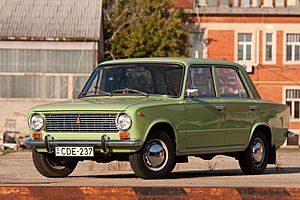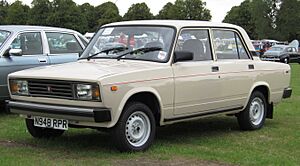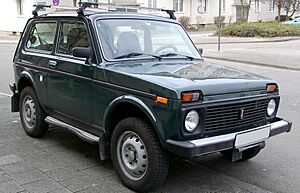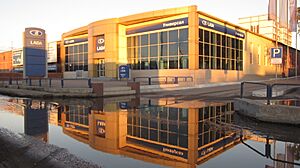Lada facts for kids
 |
|
| Owner | AvtoVAZ |
|---|---|
| Introduced | 1973 |
| Markets | Worldwide |
Lada (Russian: Лада) is a famous brand of cars. These cars are made by AvtoVAZ, a company owned by the Russian government. Lada cars are known for being affordable and offering good value.
The first cars from AvtoVAZ were made with help from Fiat. They were first called "Zhiguli." The Lada name started being used in 1973. At first, Lada cars were mostly sold outside of Russia. Later, in the 1990s, Lada became the main brand for all markets. Renault took control of the brand in 2016. However, the Russian government bought Lada back in 2022. Today, Lada is still the most popular car brand in Russia.
Contents
History of Lada Cars
How Lada Started

The AvtoVAZ car company was created through a partnership. It was a team-up between Fiat from Italy and the Soviet Union's foreign trade department. They built the factory in a city called Tolyatti in Russia. The first agreement to work together was signed on July 1, 1965.
In 1970, the company started making the VAZ-2101. This car was a stronger version of the Fiat 124 sedan. It had tougher steel parts. This made it more reliable on rough roads and in the cold Russian winters.
The first cars were called "Zhiguli." But when they started selling cars to other countries, this name was hard for people to say. So, the name Lada was chosen for cars sold outside of Russia. Lada cars were designed to be easy for owners to fix. This was important because there were not many car repair shops in the Soviet Union. Lada cars became popular in many countries. People liked them because they were cheaper than other cars. They were seen as strong and dependable cars for people on a budget. The Lada brand became the main name for all AvtoVAZ cars in 1973.
The original Fiat engine was later updated. A new engine was put in the cars. The cars also got stronger brakes and better suspension. This helped them handle poor roads. Engineers from both Fiat and Russia worked together on these improvements. By 1970, AvtoVAZ had its own team of designers.
In 1977, AvtoVAZ designers created their first car completely on their own. This was the VAZ-2121 Niva.
Lada in Modern Times
The 110-series sedan came out in 1995. A station wagon version followed in 1998. Then, a hatchback version was released in 2001. A five-door version of the Niva was also introduced in 1995.
By 1997, Lada had to stop selling cars in most Western European countries. This was because of new rules about car emissions and safety. Also, new car brands from Asia, like Hyundai and Kia, started selling affordable cars. This made it harder for Lada to compete.
In 1998, a minivan called the VAZ-2120 Nadezhda was introduced. It was based on the Lada Niva.
The new Kalina car series was launched in 2005. AvtoVAZ built a new factory for this model. In March 2007, Lada released the Priora. This was a newer version of the 110-series model.
In March 2008, the car company Renault bought a part of AvtoVAZ. This deal was worth about 1 billion US dollars. Sales of the Granta car began in December 2011. This car was developed with help from Renault. The Largus, another car with Renault technology, was launched in Russia in July 2012.
In August 2012, Lada showed off a new concept car called the XRAY. This car was designed by Steve Mattin. The second version of the Lada Kalina was also shown in 2012. Production of the Vesta started in September 2015. This car was built on a new platform developed by AvtoVAZ and the Renault-Nissan Alliance. In 2016, Renault became the main owner of AvtoVAZ and Lada. The XRAY, a compact city crossover, started selling in February 2016. In January 2021, Renault decided to combine Lada and its sister brand Dacia into one business unit.
In May 2022, Renault sold its ownership stake in Lada. It sold it to a Russian state-owned company for a very small amount of money. After this sale, the production of many newer Lada models stopped. This was because these cars used many parts from other countries. After three months, AvtoVAZ started making older models again, like the Niva. They also made a simpler version of the Granta. More advanced models could not be made due to new rules affecting Russia. In April 2023, Lada announced that a new version of the Vesta, called Vesta NG, was ready for production.
Because of international rules, Lada started making cars without airbags. They also made cars without anti-lock braking systems (ABS). This was similar to how some new cars are made in other parts of the world.
Lada's Brand and Logo
The first official logo for AvtoVAZ came out in 1970. This logo was used for all its cars. It looked like a shield with a special boat design inside. In the mid-1990s, the company introduced a new logo. This one was shaped more like an oval, but it still had the boat inside. The logo was updated again in 2002 and 2015.
In 2004, AvtoVAZ decided to use only the Lada brand name for all its cars sold in Russia. They also started writing the Lada name and car model names using the English alphabet.
Current Lada Models
- Granta
- Granta sedan
- Granta Sportline
- Granta liftback
- Granta Cross
- Granta Sport
- Vesta
- Vesta sedan
- Vesta Cross
- Vesta SW
- Vesta SW Cross
- Vesta Sportline
- Vesta SW Cross Black Limited Edition
- Vesta NG
- Largus
- Largus Universal
- Largus Universal CNG
- Largus Cross
- Largus Cross CNG
- Largus Wagon
- Largus Wagon CNG
- Niva
- Niva Travel
- Niva Legend
- Iskra
See also
 In Spanish: Lada para niños
In Spanish: Lada para niños
- Automobile model numbering system in USSR and Russia
- List of AvtoVAZ vehicles
- AvtoVAZ vehicles in international markets





